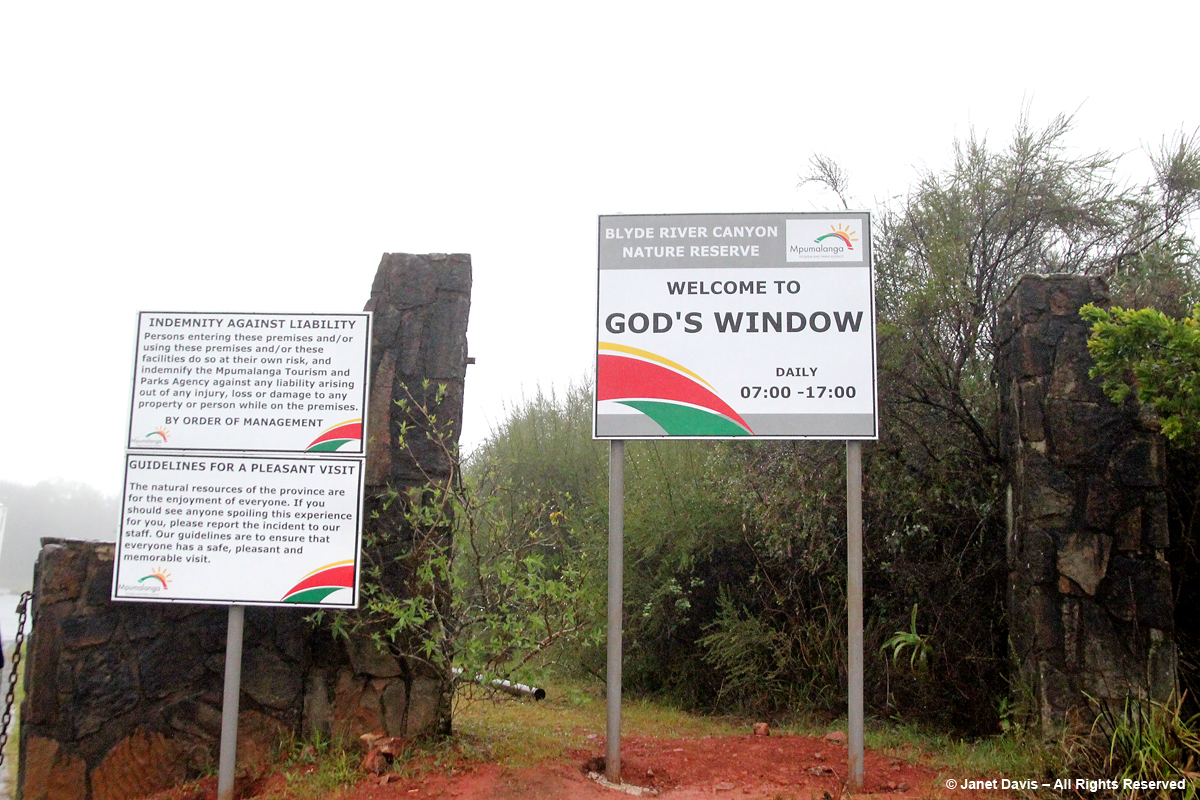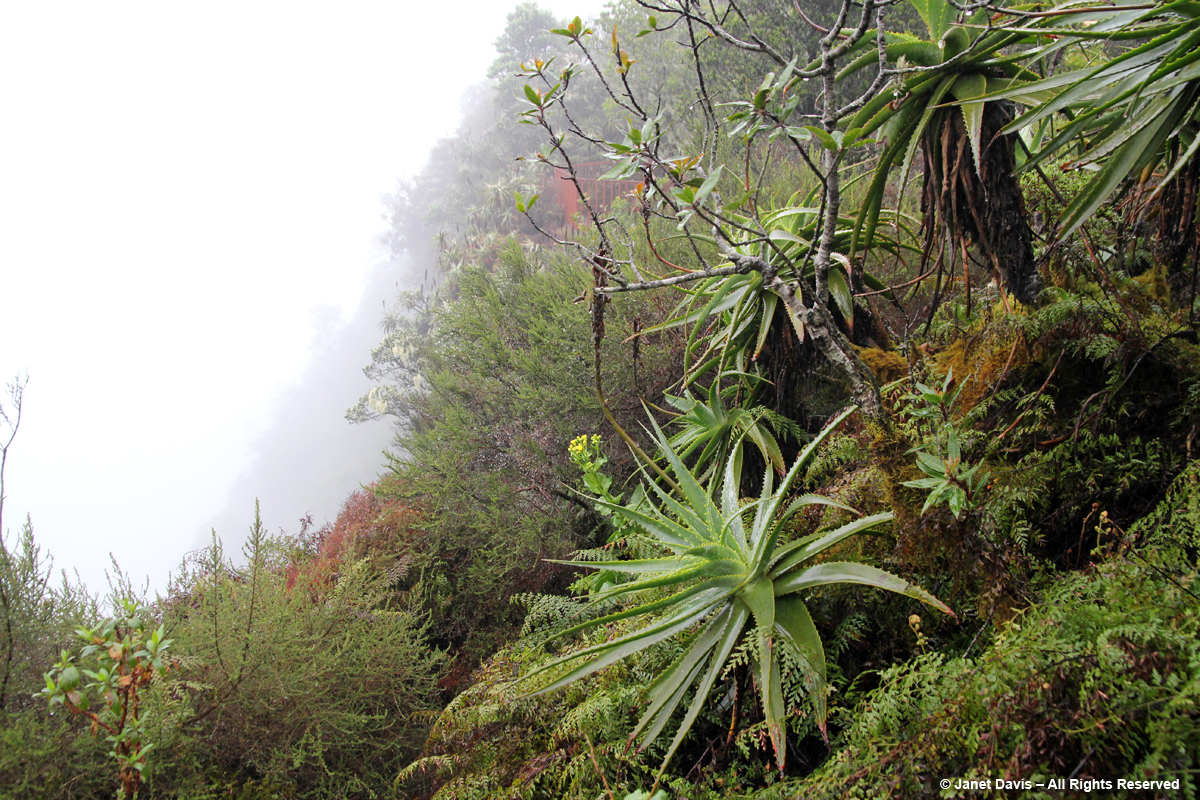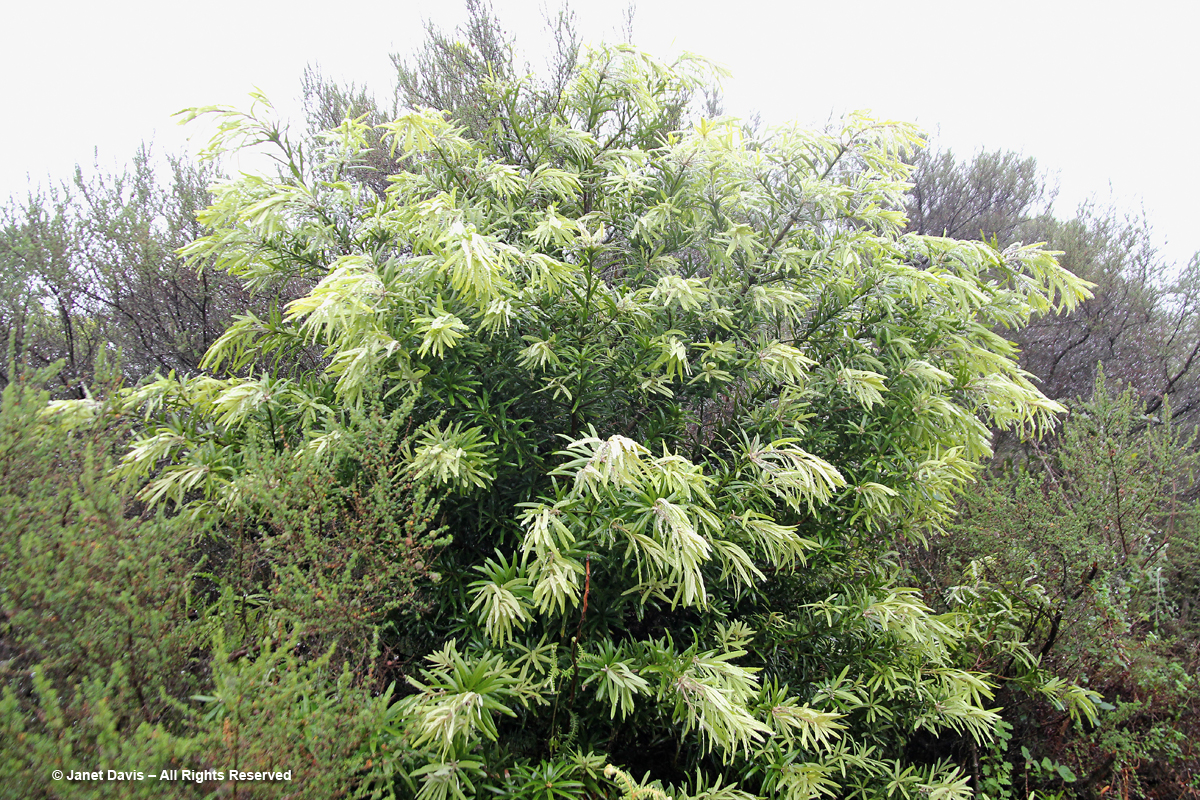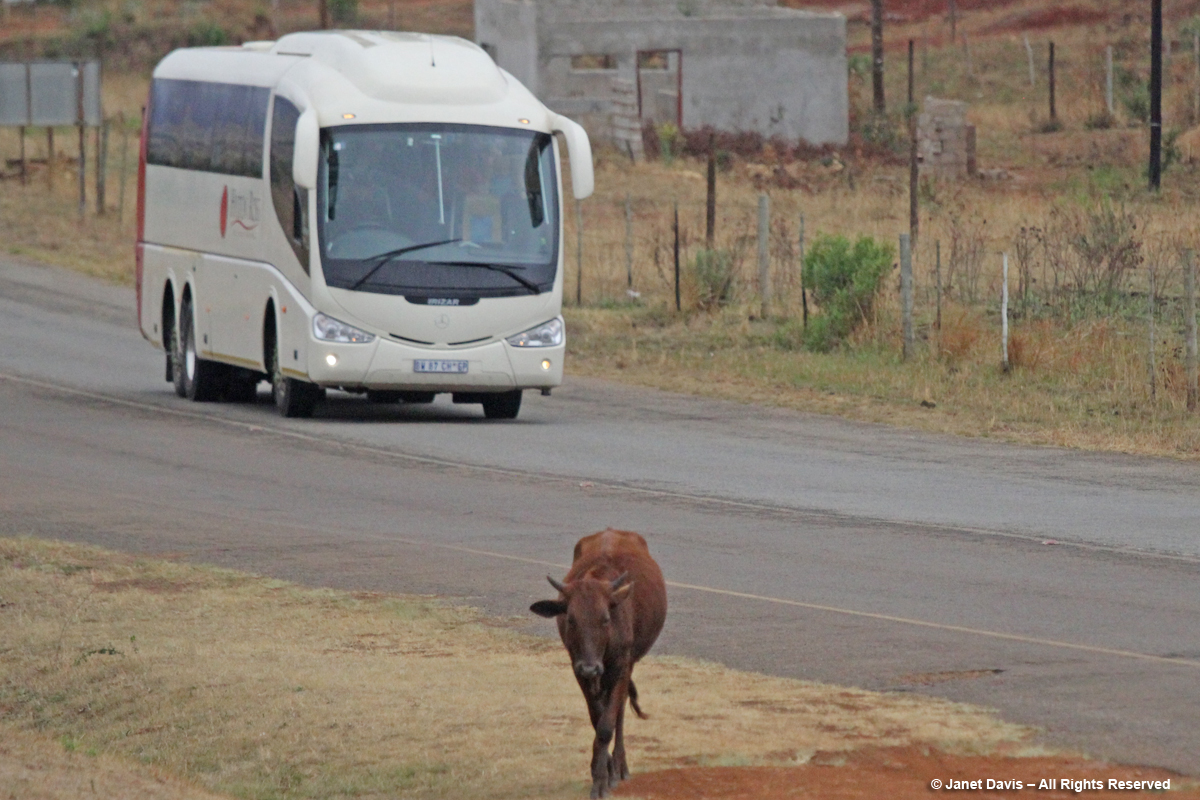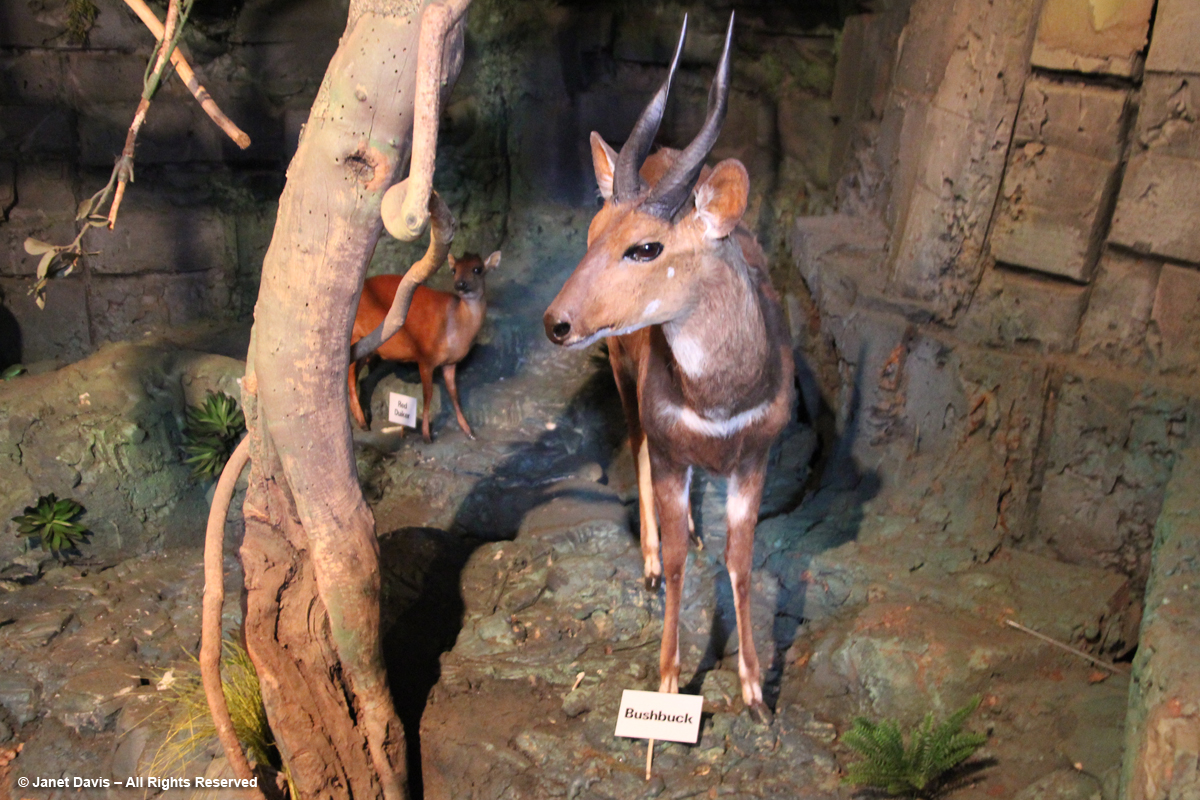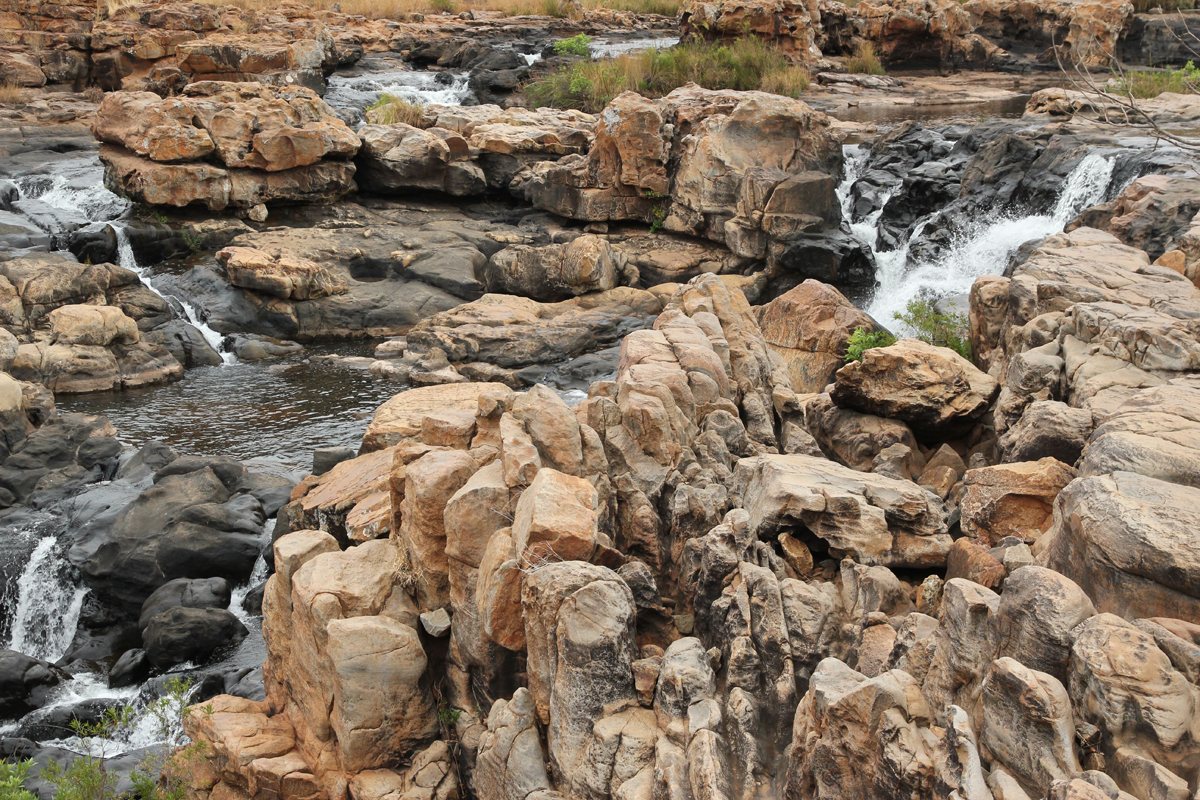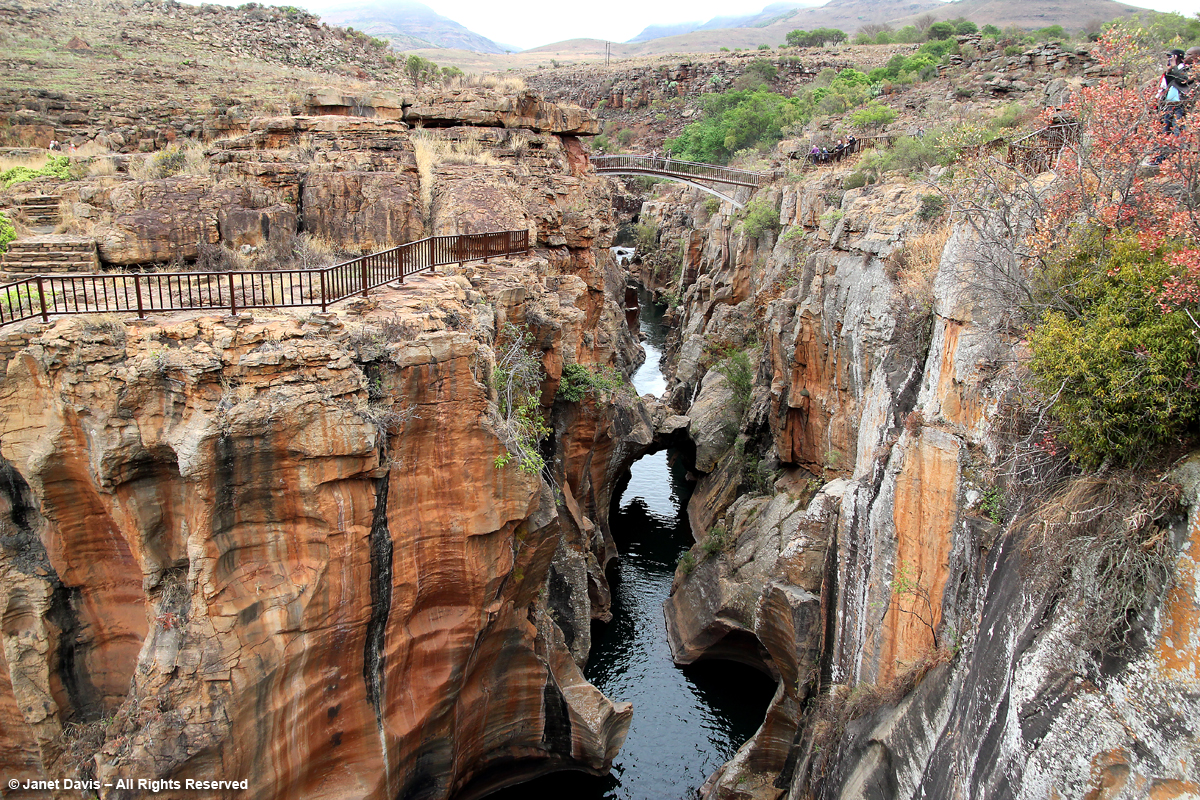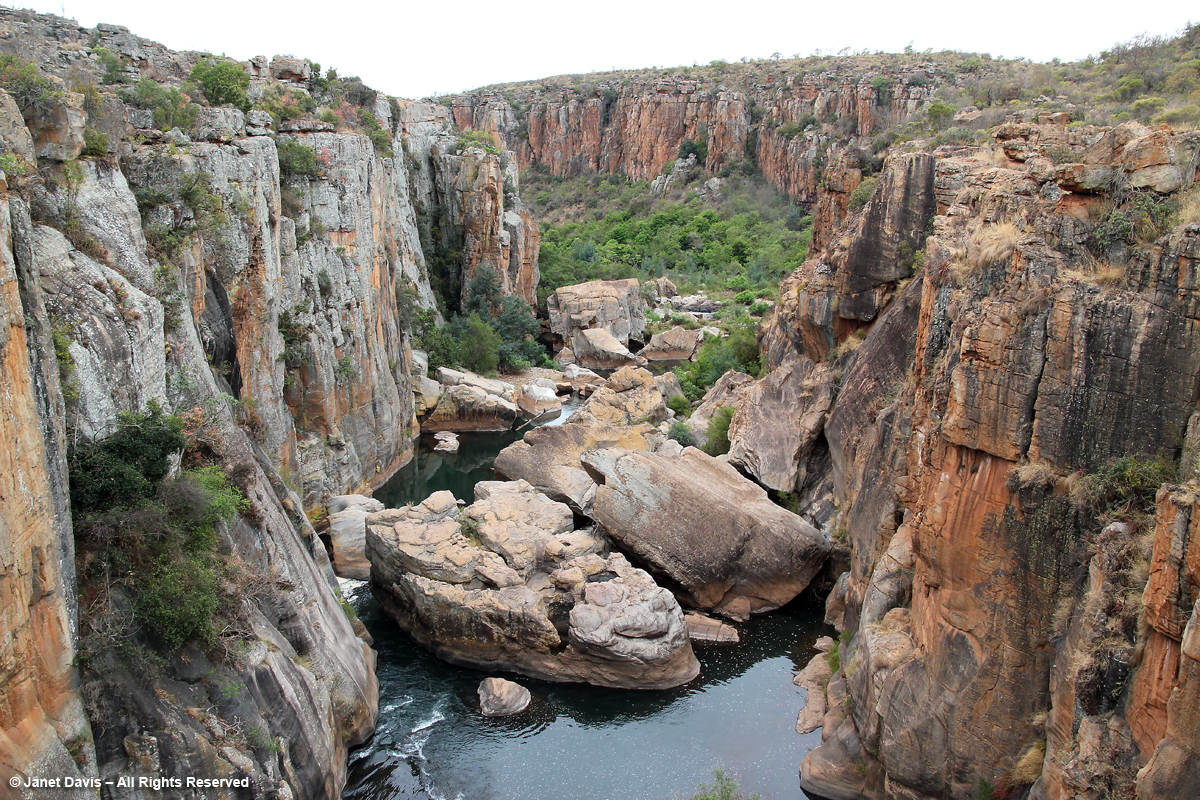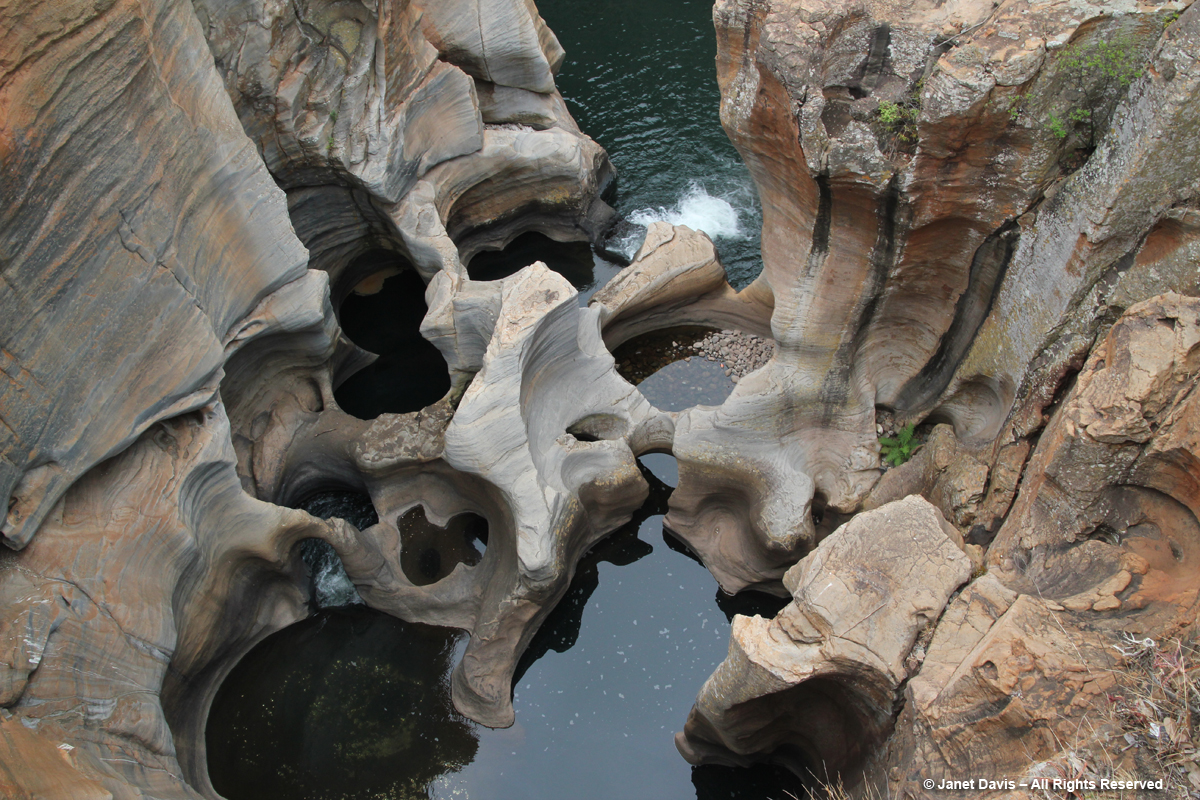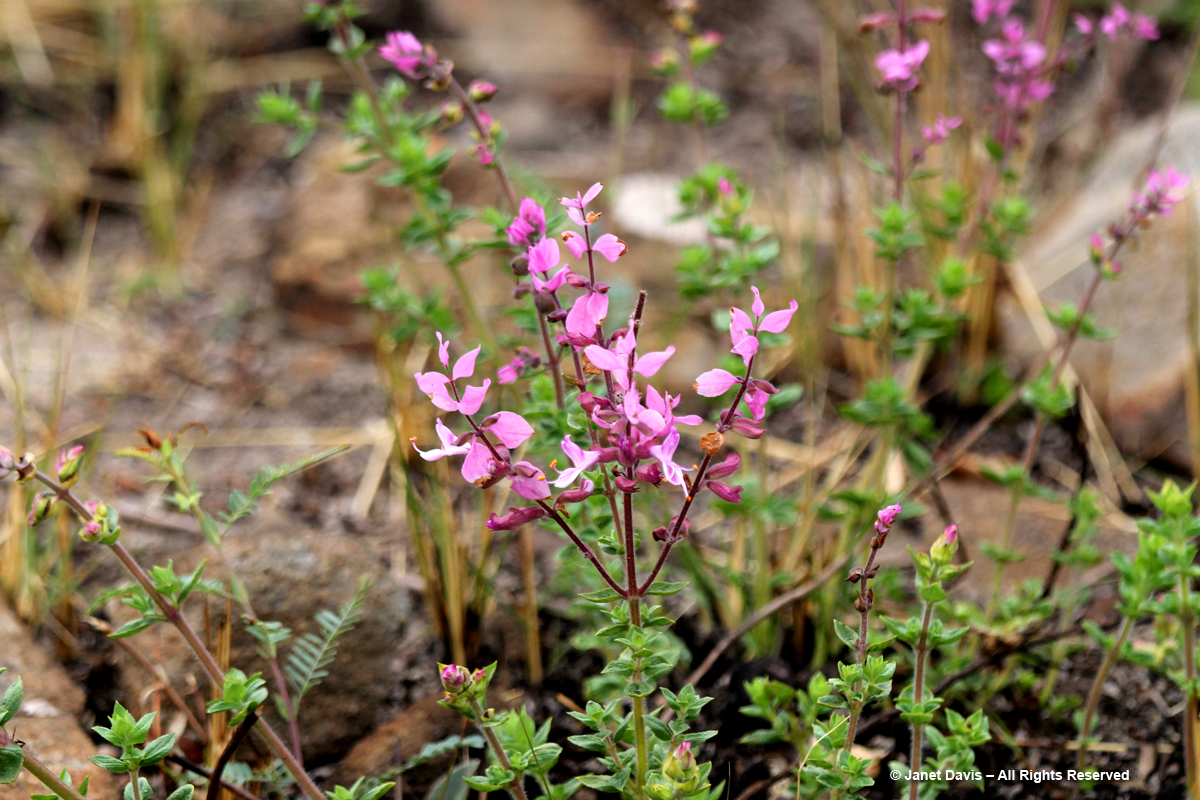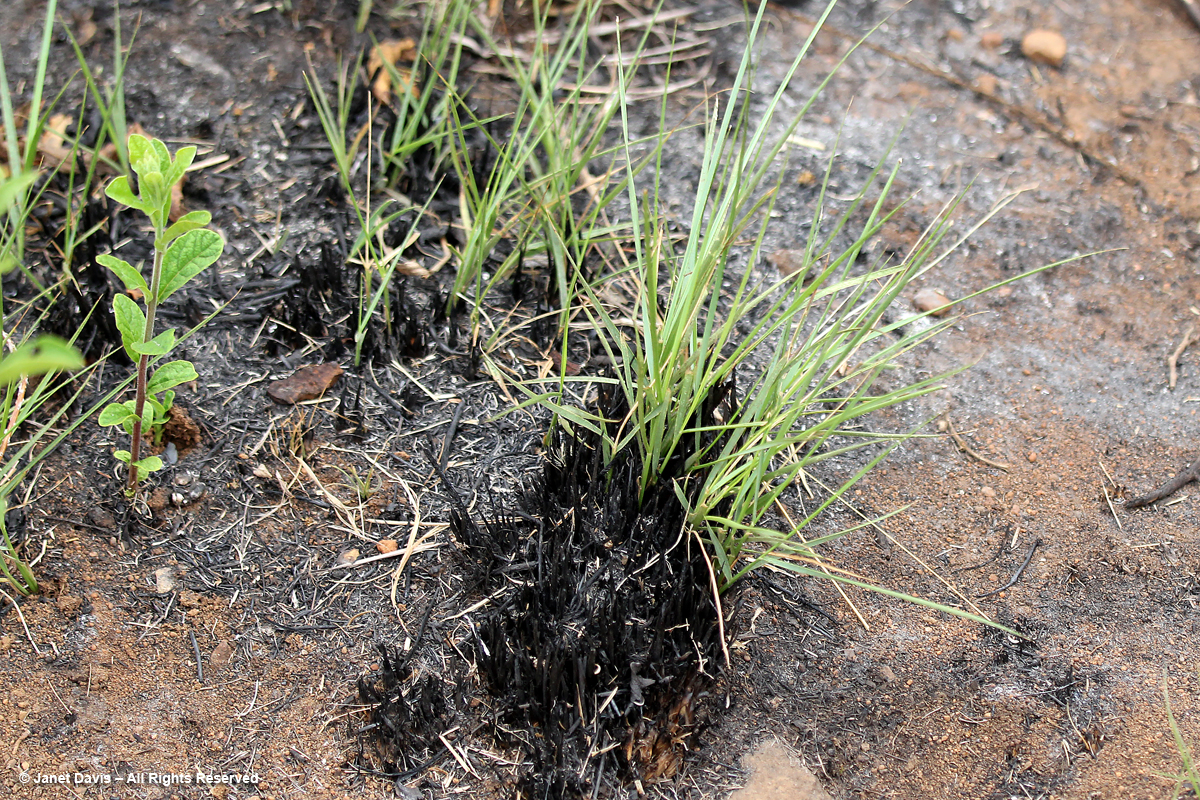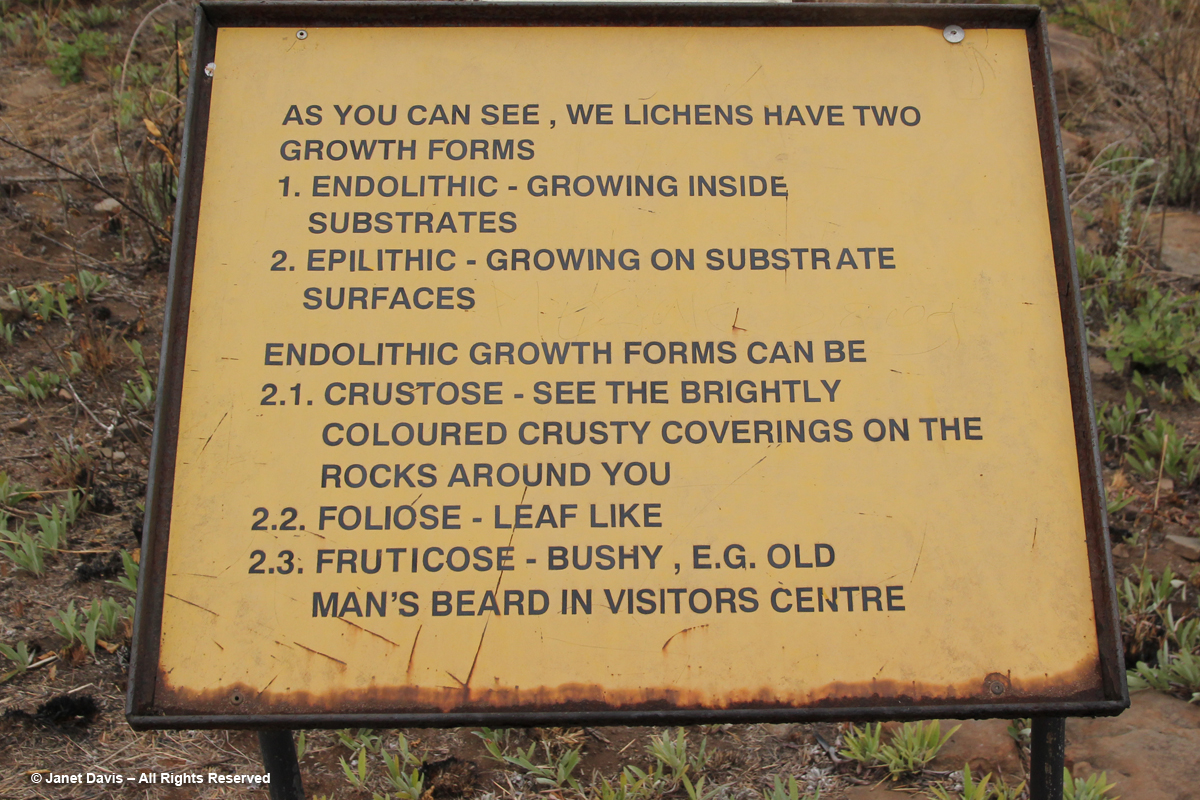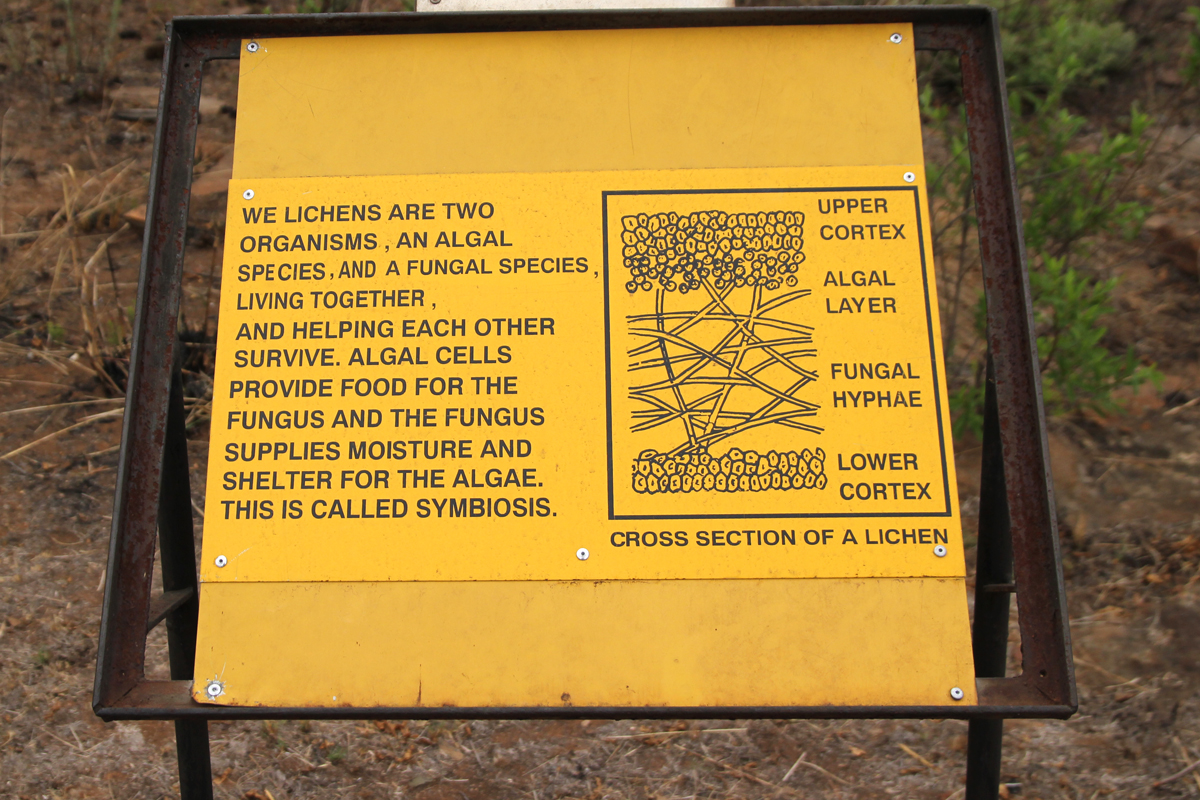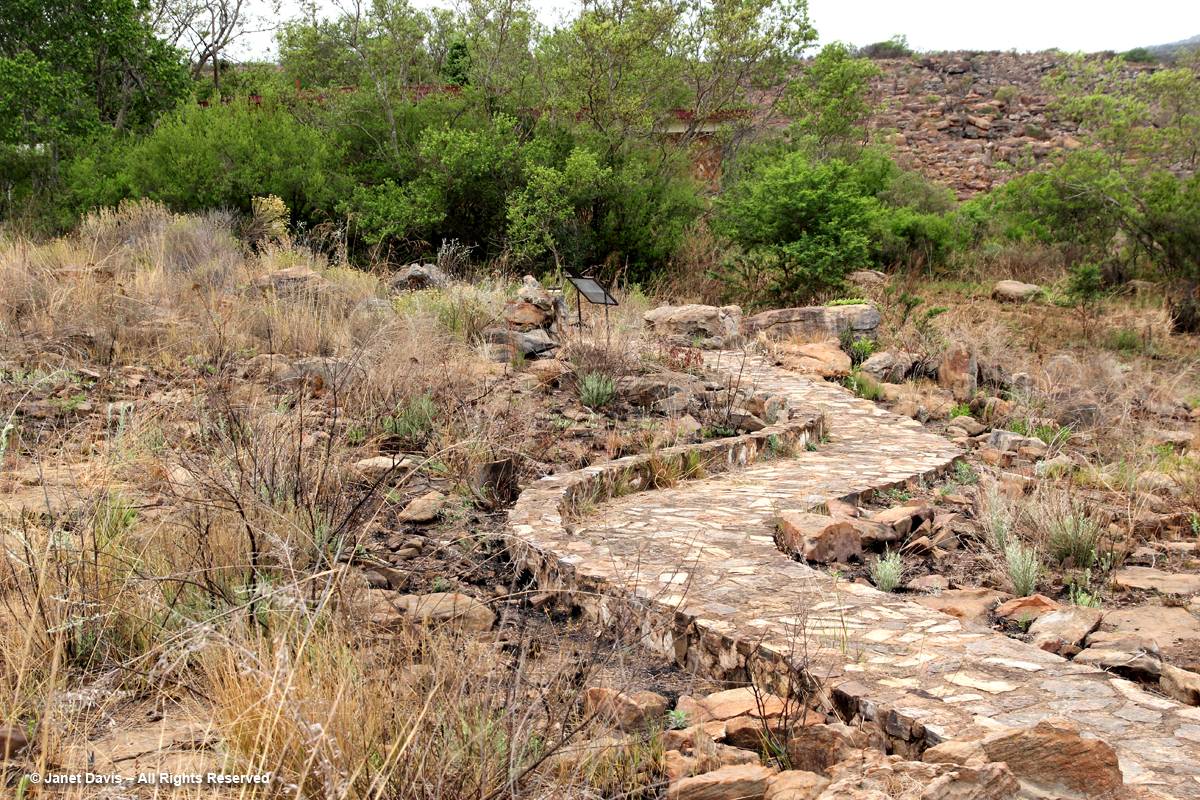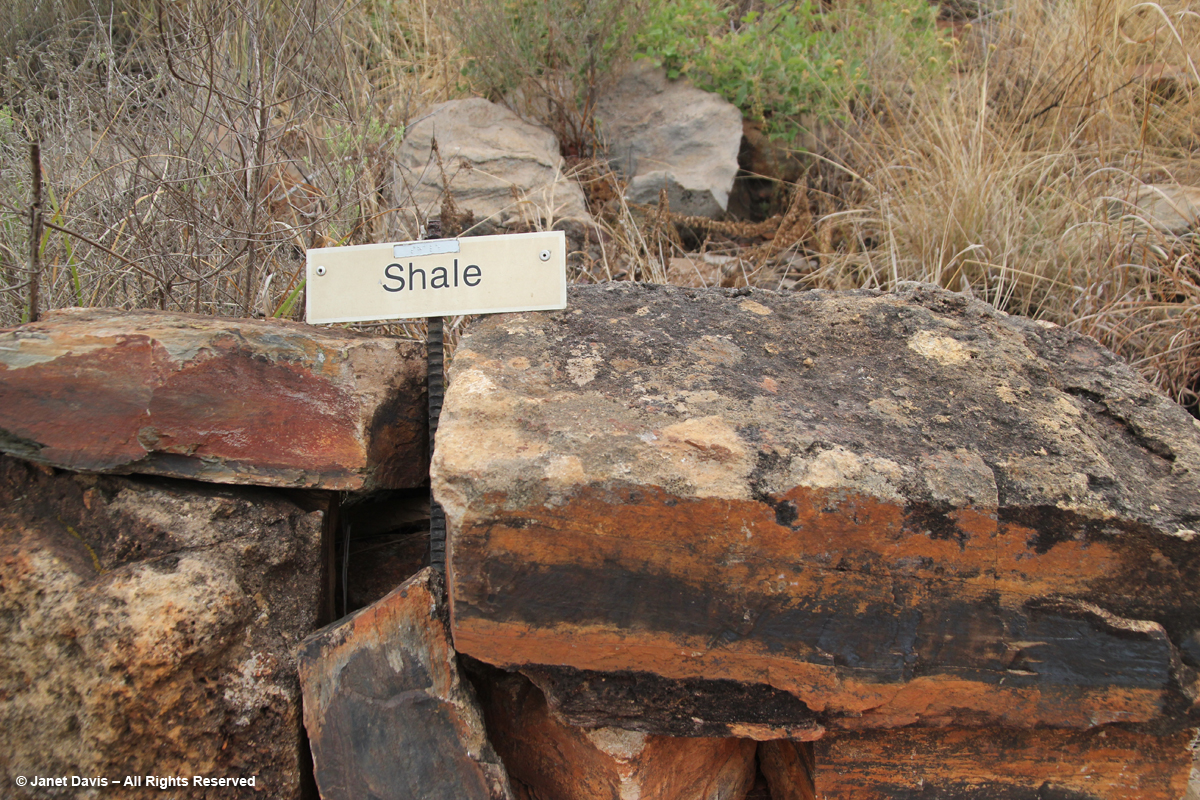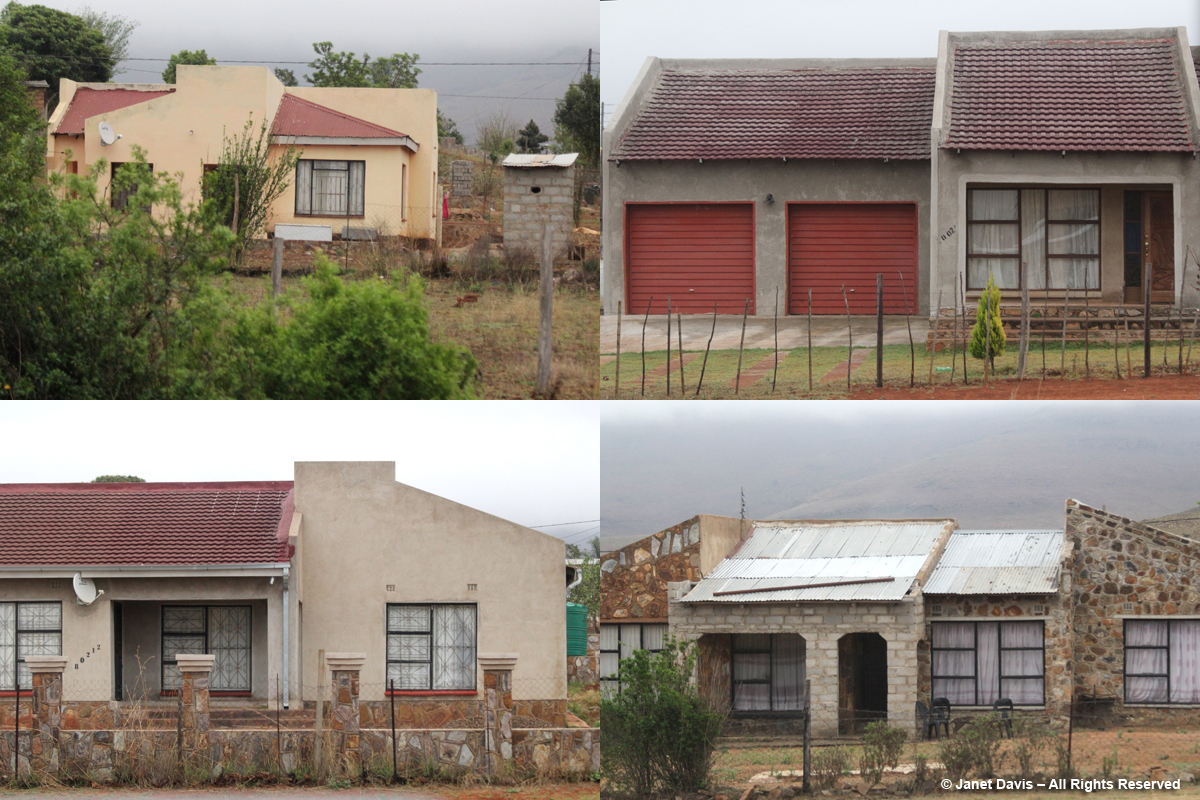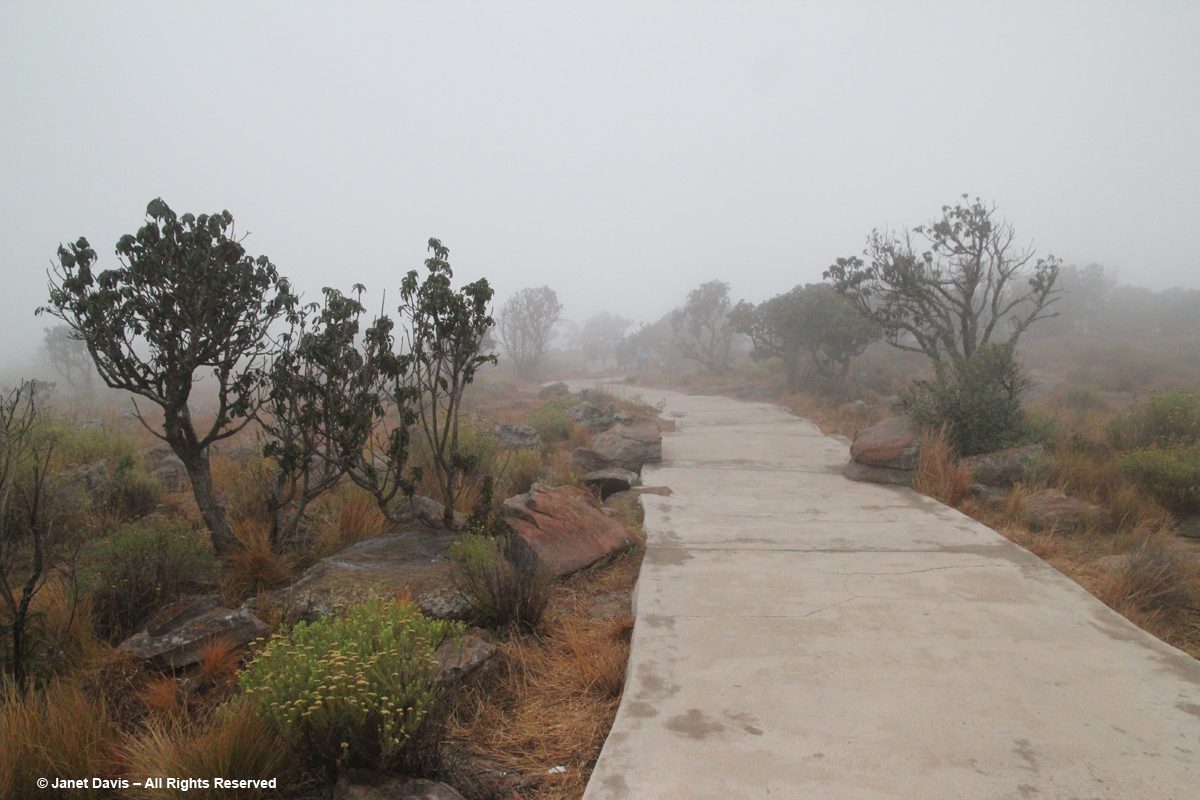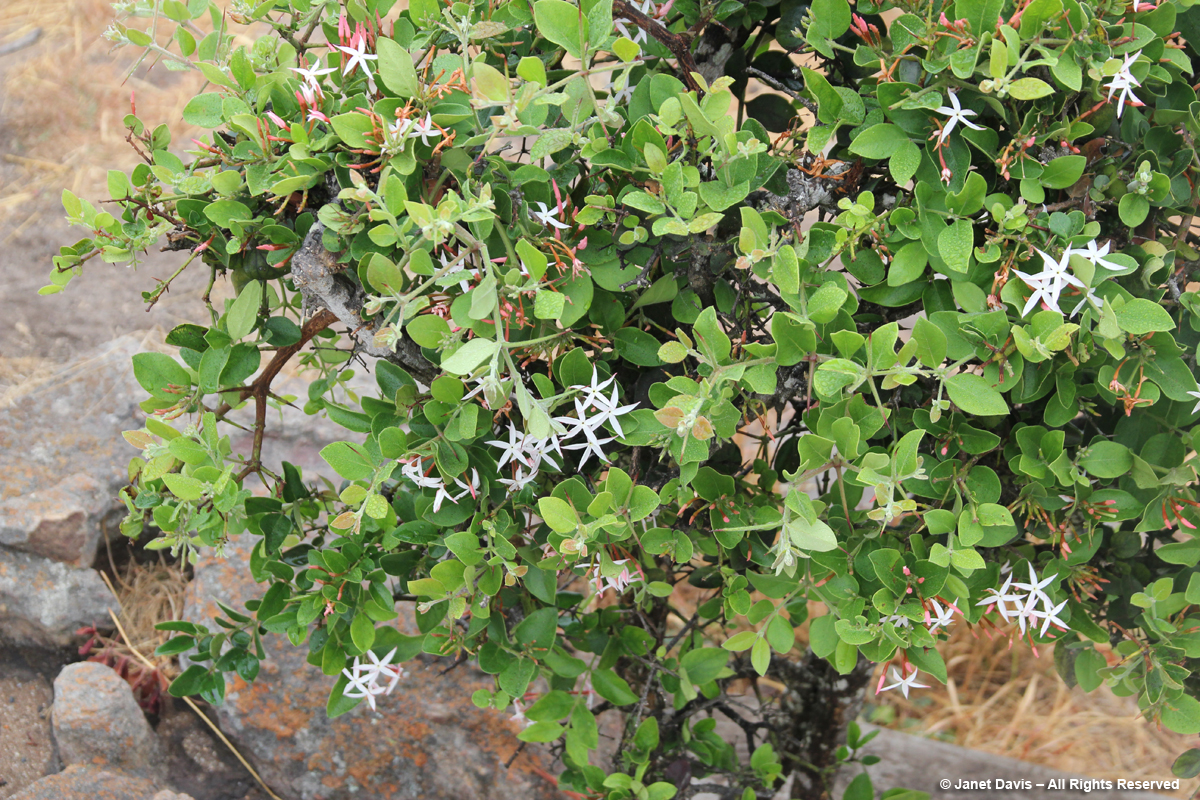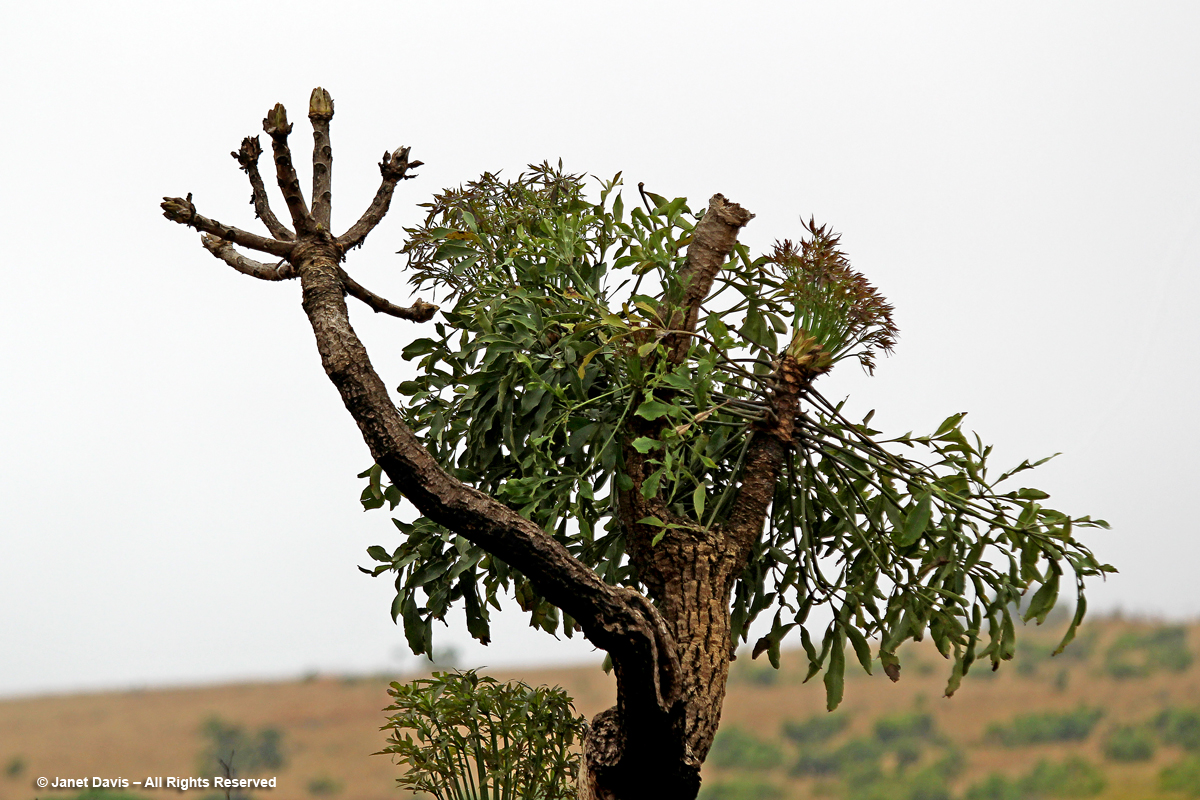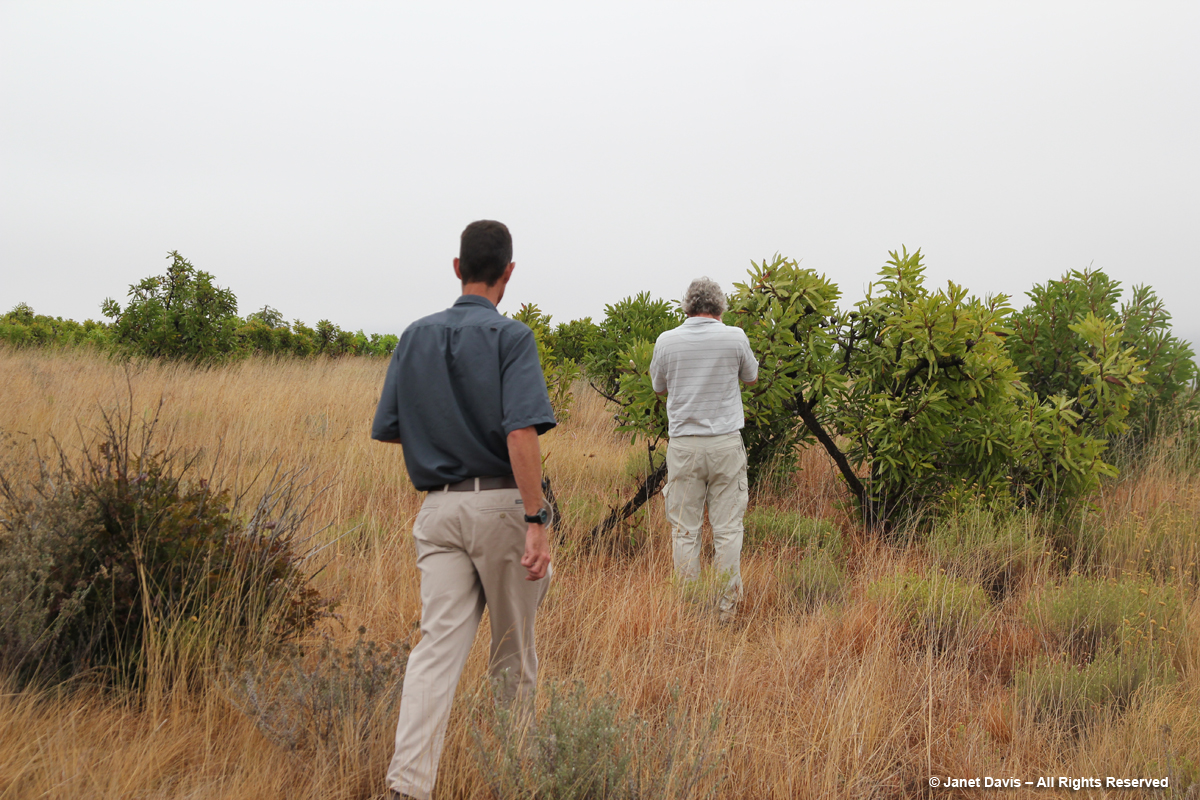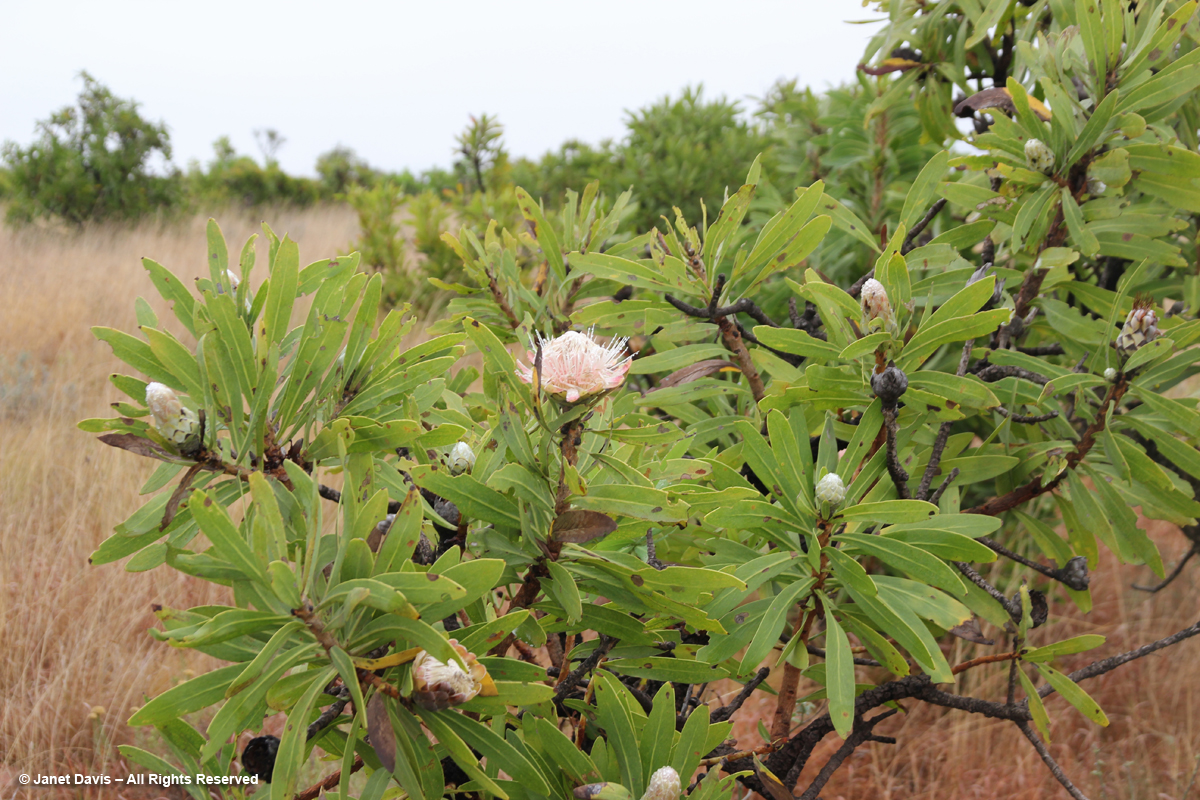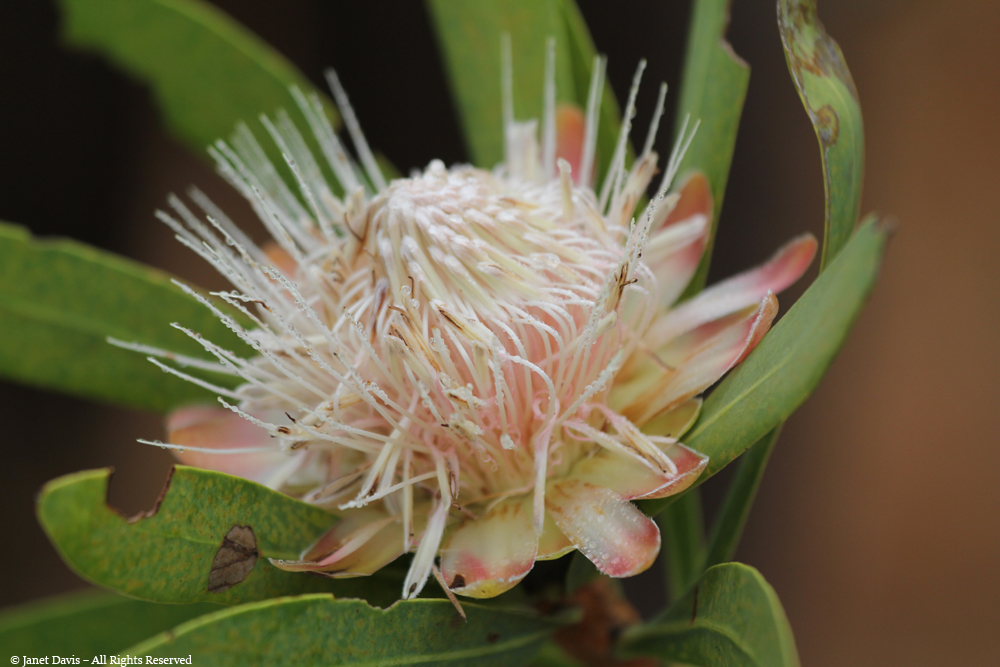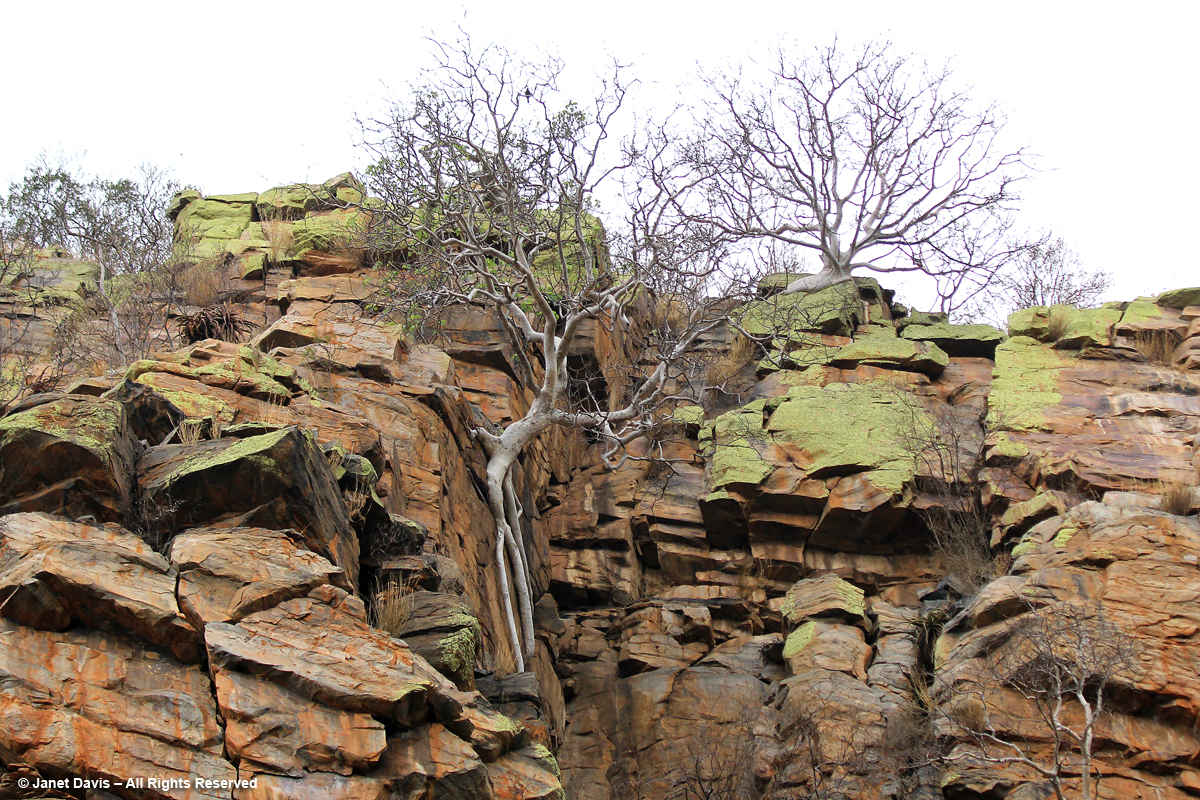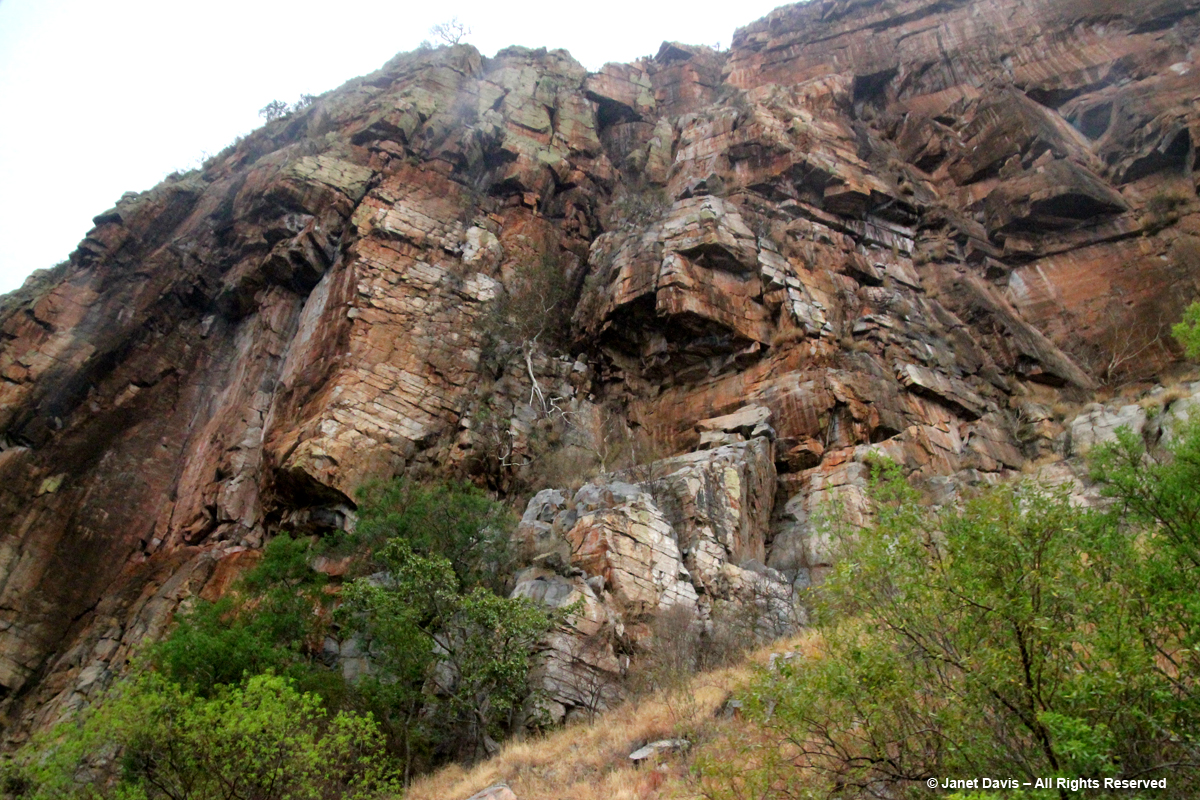It’s Day 3 on our South African Garden Tour and we’ve travelled from Johannesburg (via an overnight stay in the little town of White River) towards the Kapama Game Park near Kruger National Park. Yesterday, we saw a lot of this beautiful country from a bus window but today we’re actually getting out of the bus at a few spots to tour one of Mpumalanga’s most spectacular sites, the Blyde River Canyon Nature Reserve. Our first stop is at a lookout called God’s Window.
Though it must be spectacular on a clear day, there’s a good reason why this part of the Drakensburg Escarpment is called the Mist Belt, where moisture rises from the lowveld 1200 metres below. But the little I can see of this montane forest with its slopes carpeted with aloes and ferns is stunningly beautiful.
The mist has condensed on this yellowwood tree (Podocarpus latifolius). We saw yellowwoods in gardens in Johannesburg, but it is wonderful to see it here in nature.
After taking in the non-view, we get back on the bus and drive a little further down the road to the Bourke’s Luck Potholes. A Nguni cow grazes on the side of the highway at the entrance. Nguni cattle have a rather storied history in the country. Their ancestors were brought by the Xhosa, Zulu and Swazi people during their migration to southern Africa between 600 and 1400 AD. The famous Zulu king Shaka (1787-1828) seized control of the Nguni herds in the areas he controlled and later bred them according to colour and patterns, pure white being the colour of his royal herd. Nguni cattle are still used today as a bride’s dowry or lobolo.
The nature conserve headquarters features a quaint little display of animals native to the canyon.
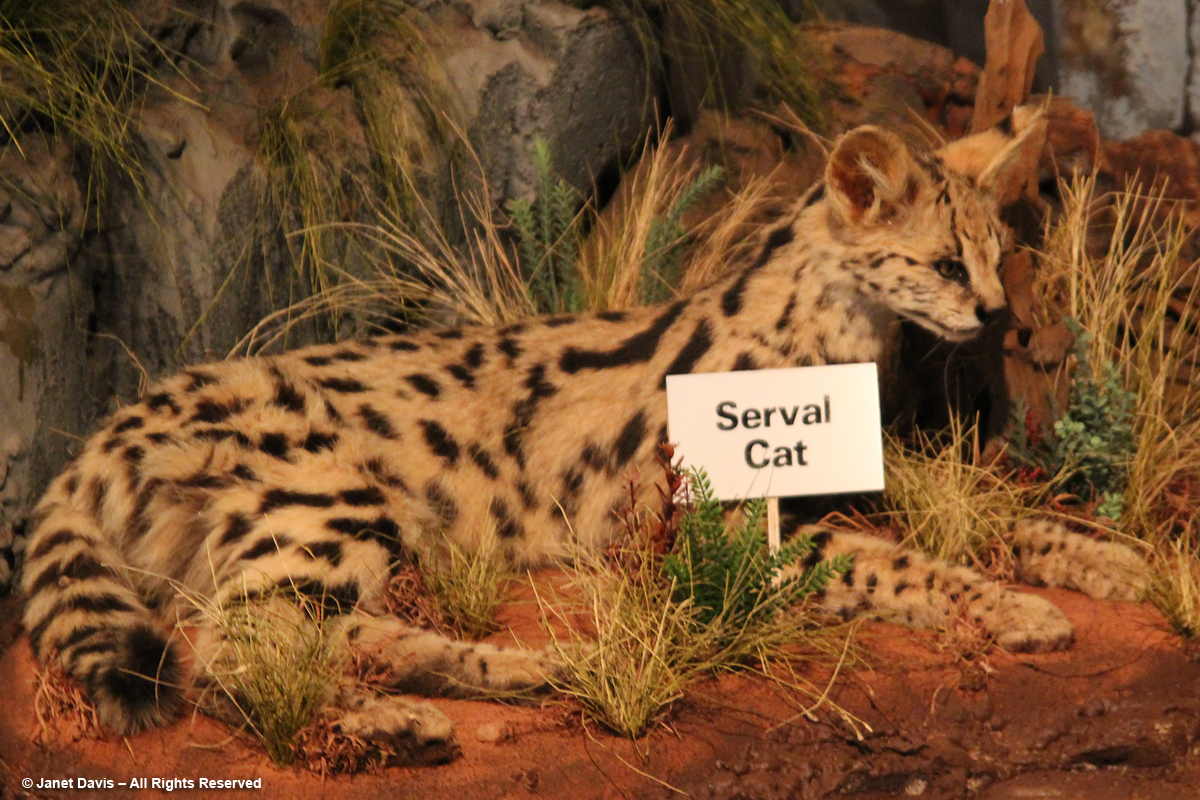 Other indigenous animals include the mongoose, chacma baboon, leopard, civet cat, spotted genet and caracal.
Other indigenous animals include the mongoose, chacma baboon, leopard, civet cat, spotted genet and caracal.
But the main attraction is the spectacular juncture at which the Treur River descends through the rocky sandstone landscape to fall…..
…..into the Blyde River below. The Blyde River Canyon is 26 kilometres (16 miles) long and averages 750 metres (2460 feet) in depth.
Both rivers were named by followers of the Voortrekker (Afrikaner emigrants from the British Cape Colony) leader Hendrik Potgieter who in 1844 left his main trek and set off with a few men for Mozambique to make contact with the Portugese there. When he failed to return, the sorrowful men and women left behind headed west along a river they named Treur, the Dutch word for sadness or grief. But days later, Potgieter caught up with them on another river, which they named Blyde, the Dutch word for joy (and the same root as the word “blithe”).
The canyon scenery is stunning, the massive boulders tipped on their sides here and there along its course.
It was the action of sandstone gravel in the kolks (the Dutch word for the whirlpool-like vortices that occur when water rushes past an obstacle) in the plunge pools from the Treur River into the Blyde that scoured out the cylindrical potholes or kettles we can see from high above. They were named for a local prospector, Tom Bourke, who correctly predicted that gold would be found in the area (it was found at nearby at Pilgrim’s Rest, among other places), but did not find any himself.
Above the Blyde River, I note a number of interesting plants, like this pretty pink Mpumalanga sagebrush (Syncolostemon transvaalensis).
Lightning-caused fires are common in this area but plants like these grasses have adapted to fire and re-sprout quickly.
The plant below, shown at left after a fire and at right in nearby grassland, was a mystery for me until I presented it to my Plant Identification group on Facebook. It looked a little like an acacia or mimosa, but I was puzzled as to how such a small sapling would be sexually mature enough to put forth such a profusion of flowers. It made so little sense to me that I was convinced it was a herbaceous plant. But one extremely knowledgeable Belgian plantsman identified it as a shrub or small tree called Elephantorrhiza elephantina or elephant’s root (also known as eland’s bean or wattle).
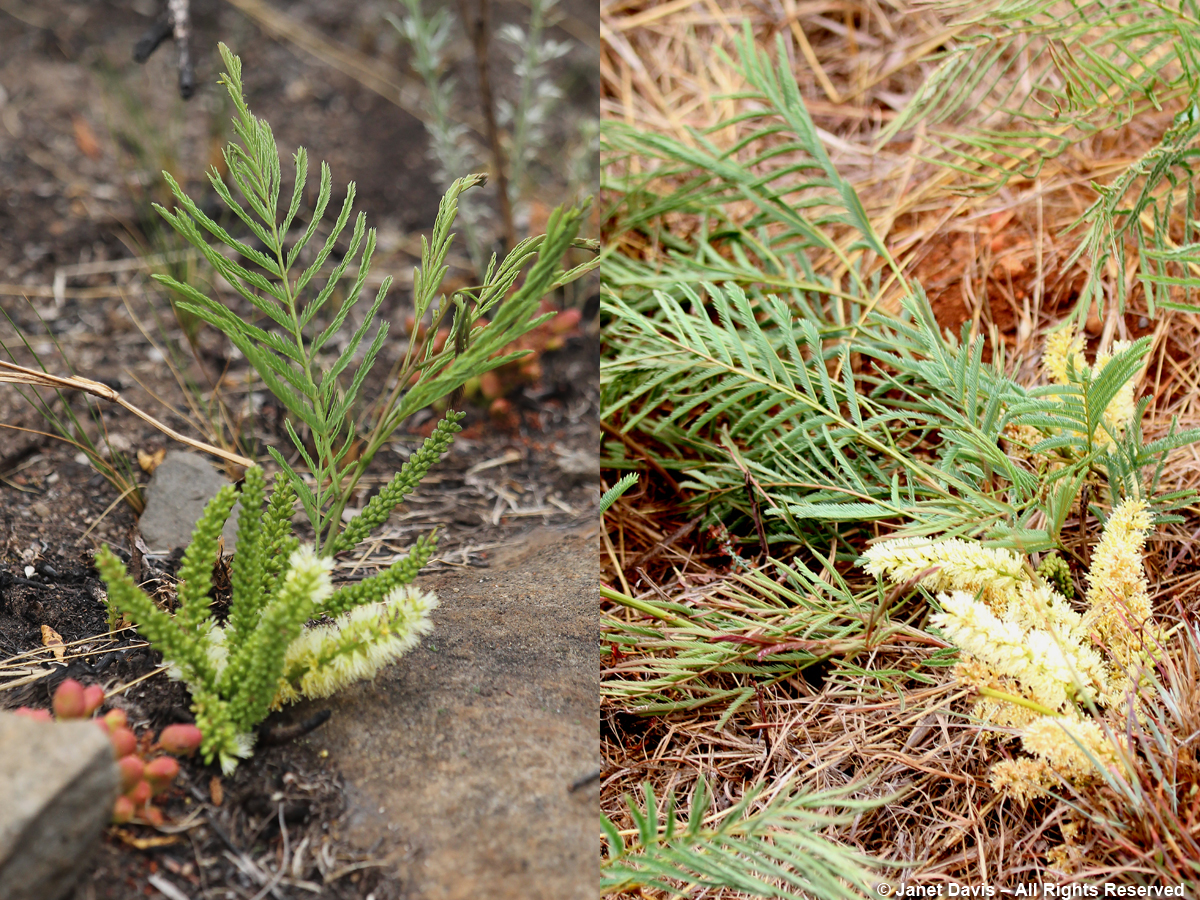
And in a country with so many languages, it’s not surprising that this one has many: elandssboontjie or olifantswortel in Afrikaans and intolwane in Xhosa and Zulu, to name just a few. But the habit of elephant’s root is remarkable in two ways. First, it is “caudiciform”, meaning its above-ground growth emerges from a massive, tuber-like, underground root called a caudex (like the desert rose Adenium obesum, for example). Second, it is a “geoxylic suffrutex”, a sub-shrub that makes wood like regular trees and shrubs, but dies to the ground in adverse conditions only to re-emerge when conditions are favourable. It turns out that elephant root lives underground in large forests that can be very ancient, having evolved to protect them from frequent grazing and the wildfires that can raze South African savannahs. Thus the “young” trees in the photos above might actually be dozens or hundreds of years old. This fascinating aspect of botanical survival was described in a BBC Earth feature titled “Why Some Trees Live Underground”.
Another fun feature of the Bourke’s Luck Potholes is the Robert Filmer Lichen Trail.
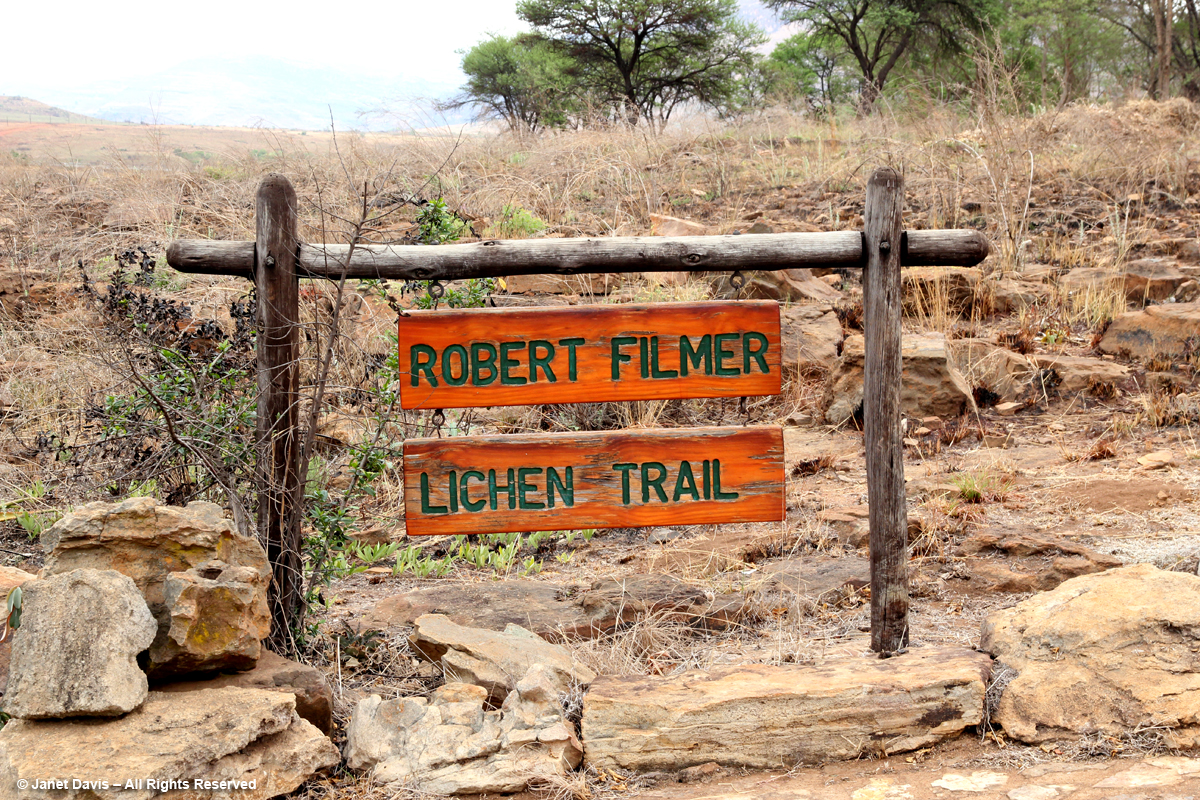
It’s a garden that explains and displays the various types of lichen that thrive in the misty conditions of the canyon……
….and it shows the unique life cycle of lichens and how they grow.
We walk along a trial with interpretive signs……
……. that also show the typical rocks of the area.
We have one more stop before the Kapama Game Park, and as we drive down the road we pass a number of typical houses in this rather remote countryside.
We arrive at the Three Rondavels where there is a walkway through typical indigenous forest to the lookout. Sadly, the mist makes the spectacular view of the formations impossible. Fortunately, there is the internet to show us what we missed.
But all is not lost – I take note of the interesting plants growing here, like the num-num tree or Natal plum (Carissa macrocarpa).
Also growing nearby are the so-called cabbage trees (Cussonia spicata) that have become popular ornamentals in South Africa and elsewhere where they are hardy.
And two of us have spotted a sugar bush (Protea repens) on the way to the viewpoint so on the way out we persuade our guide Deon Romijn to have the bus driver stop so we can photograph it. We’re cautioned about snakes as we walk through the savannah grasses accompanied by Deon.
And here it is…….
We are so excited to have our very first look at a South African protea growing in the wild.
But now we’re back on the bus and travelling out of Mpumalanaga into Limpopo province, I gaze out the window and marvel at the tenacity of the sycamore fig (Ficus sycomorus) clinging to life on the lichen-rock face. It reminds me of some of the trees at Angkor Wat in Cambodia.
And I marvel at the amazing rock formations in this beautiful part of the country, imagining the tectonic forces that must have prevailed here 120 million years ago under Africa’s Jurassic predecessor continent Gondwana, as massive eruptions of basalt lava succeeded in cleaving away the chunks of land we now know as Antarctica, Madagascar, India and Australia.
And I might even nod off a little as we roll down the highway towards our date with South Africa’s majestic animals at Kapama Game Park.
So do join me in my next blog in the new year, as I take you on safari with me.

